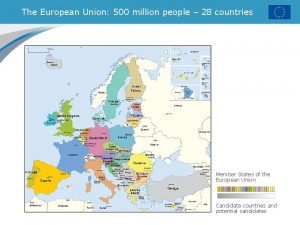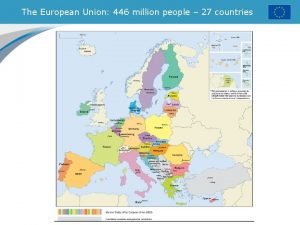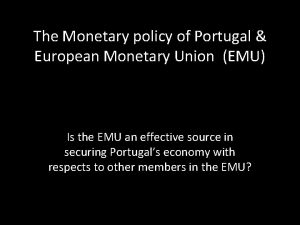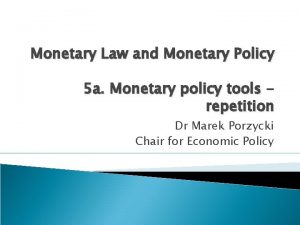European Monetary Union Gains and loss from a











- Slides: 11

European Monetary Union: Gains and loss from a monetary union Prof. C. San Juan Reference: A. M. El-Agraa. The European Union. Economics and Policies. Financial Times. Prentice Hall. 2004 (7 Th. Edition) pp. 144 -155

Gains from a monetary union § 1. Reduce the EU dependence on the dollar § 2. The Euro is a major world currency able to compete with the Japanese Yen and the US dollar § 3. Reduction in the cost of financial management § 4. Permanently fixed exchange rates among members of a monetary union for free trade and factor movements § 5. When a monetary union establishes a central fiscal authority with its own budget, then the larger the size of this budget, the higher the degree of fiscal harmonization

Loss due to a monetary union § Fleming-Corden analysis § Assume there are 3 countries involved: H (host country), P (potential partner country), W (rest of the world) § In order to maintain internal and external equilibrium, H needs to devalue its currency relative to W, P needs to revalue its currency relative to W § However, if they are in an exchange-rate union, H and P must devalue or revalue their currency together § If countries deprive themselves of rates of exchange as policy instruments, they impose on themselves losses that are essentially losses emanating from enforced departure from internal balance

Graph of the Fleming-Corden analysis of monetary integration

Introducing vertical Phillips curve § The previous model is base in the traditional Phillips curve that assume a trade-off between unemployment and inflation. § The next step is modify the model introducing the vertical Phillips curve that asume a natural unemployment rate characteristic of each country. § Under these NAIRU (non accelerating inflation rate of unemployment) model the long run unemployment rate is constant, so the Phillips curve is vertical (see next graph)

Graph of vertical Phillips curve

Implications of the change from normal Phillips curve to vertical § 1. Monetary integration will have no long-term effect on either partner’s rate of unemployment since this will be fixed at the appropriate natural rate for each country § 2. If monetary integration is adopted to bring about balanced growth as well as equal natural rates of unemployment, this can be achieved only if other policy instruments are introduced to bring about uniformity in the two labor markets

Monetary integration with expectationsaugmented Phillips curves

Reasons for the invalidity of the Fleming-Corden conclusion § 1. The monetary union is not forgoing the availability of exchange rate variations relative to the outside world § 2. The situation does not lead to surplus regions financing deficit regions indefinitely because no single region is likely to be in deficit or surplus permanently § 3. Assumptions made by Fleming and Corden are extremely controversial § 4. In practice there would never be a separation between the exchange-rate union and market integration. Devaluation is nothing but a temporary adjustment device as the discussion of the monetary approach to the balance of payments has shown

The Five Test Framework for the UK to integrate in the Eurozone § 1. Are business cycles and economic structures compatible so that we and others could live comfortably with euro interest rates on a permanent basis? § 2. If problems emerge is there sufficient flexibility to deal with them? § 3. Would joining EMU create better conditions for firms making long-term decisions to invest in Britain? § 4. What impact would entry into EMU have on the competitive position of the UK`s financial services industry, particularly the City´s wholesale market? § 5. In summary, will joining EMU promote higher growth, stability and a lasting increase in jobs?

References § El-Agraa, Ali M. (1999): The economics of the European Community. Harvester Wheatsheat. 4 th edition. § http: //ideas. repec. org/p/san/crieff/9620. html § http: //interzone. com/~cheung/SUM. dir/econthy m 1. html § http: //www. euro. gov. uk/
 The method of unit costing is adopted by
The method of unit costing is adopted by Union union all intersect
Union union all intersect 1993 europa
1993 europa European union institutions
European union institutions Co-funded by the erasmus+ programme of the european union
Co-funded by the erasmus+ programme of the european union Co-funded by the erasmus+ programme of the european union
Co-funded by the erasmus+ programme of the european union European union 28 countries
European union 28 countries European union 28 countries
European union 28 countries European union military
European union military Borchert model ap human geography
Borchert model ap human geography Https://europa.eu/european-union/index_en
Https://europa.eu/european-union/index_en This project is funded by the european union
This project is funded by the european union





















